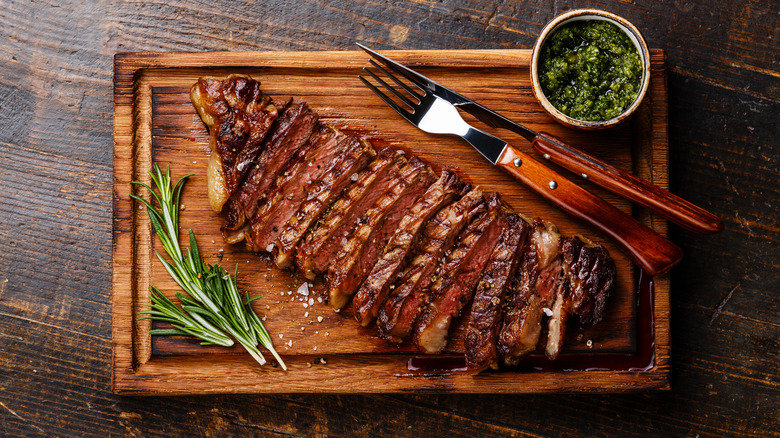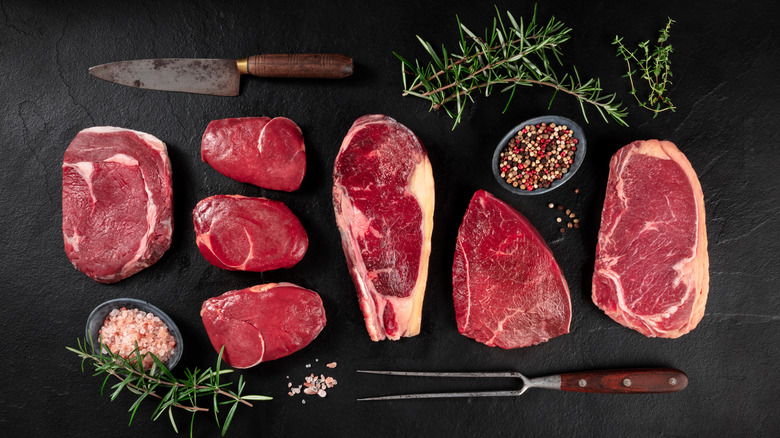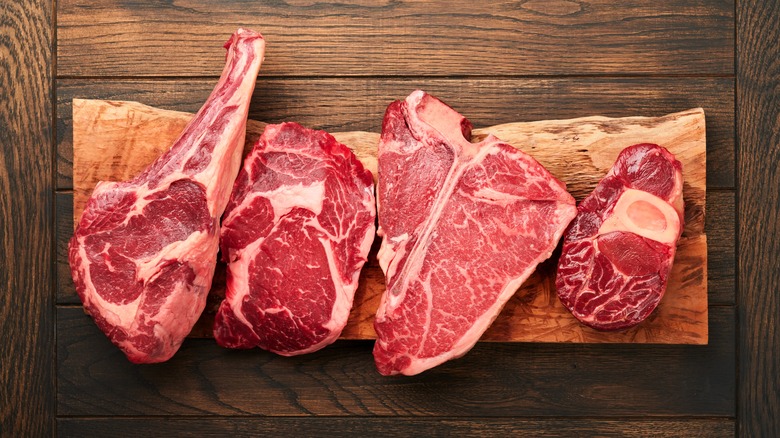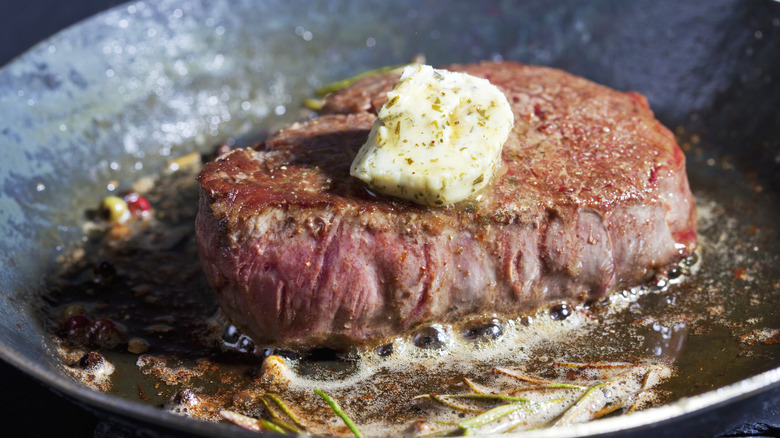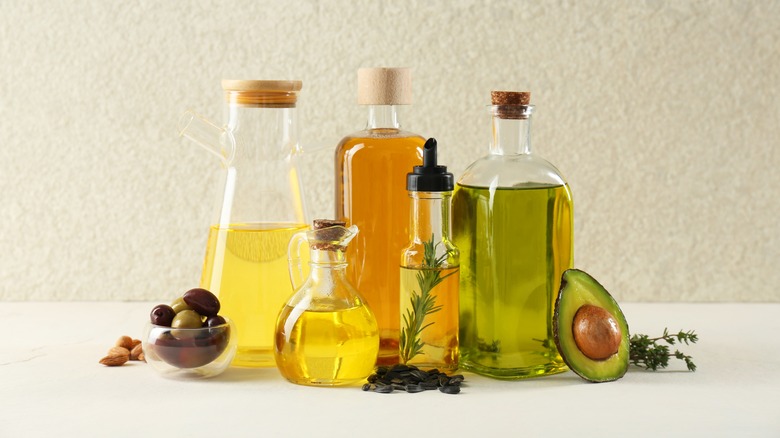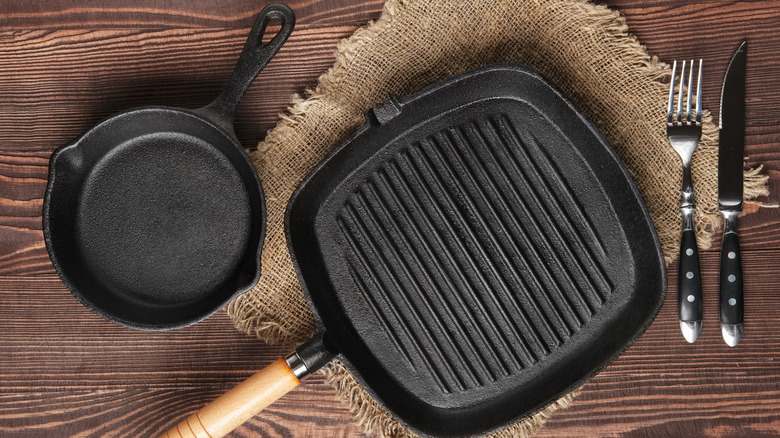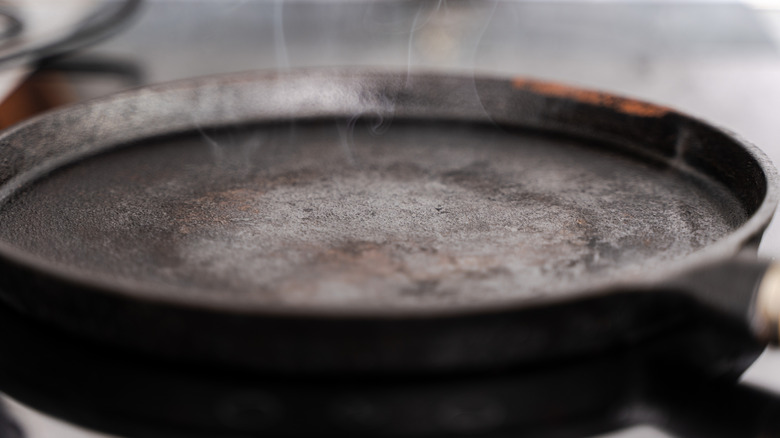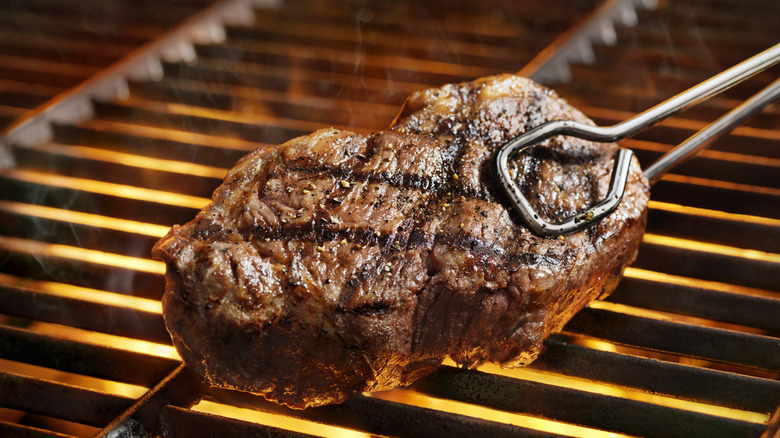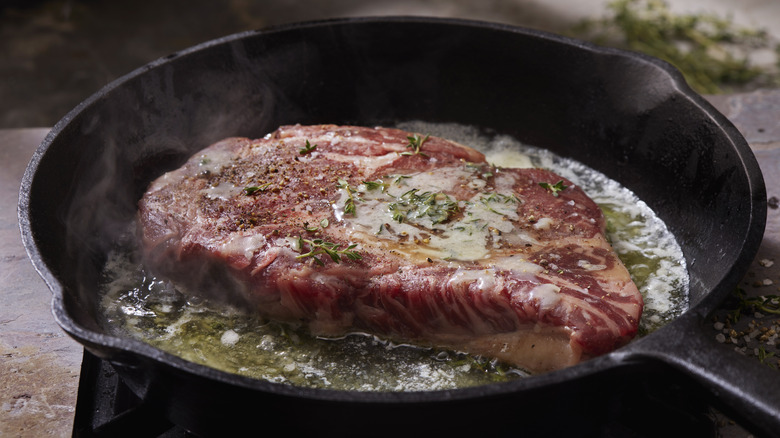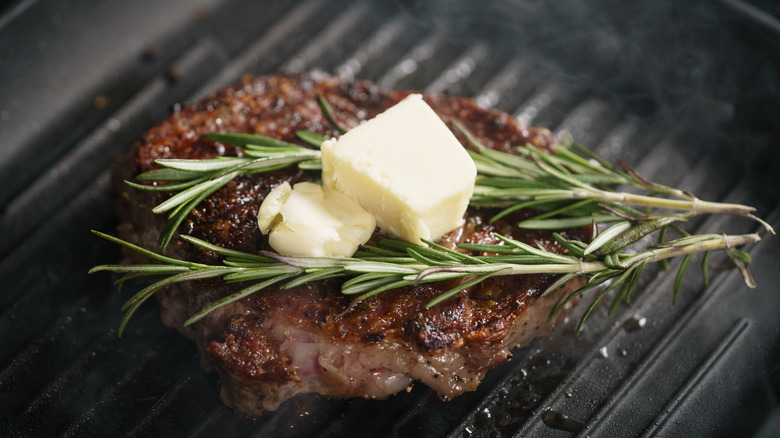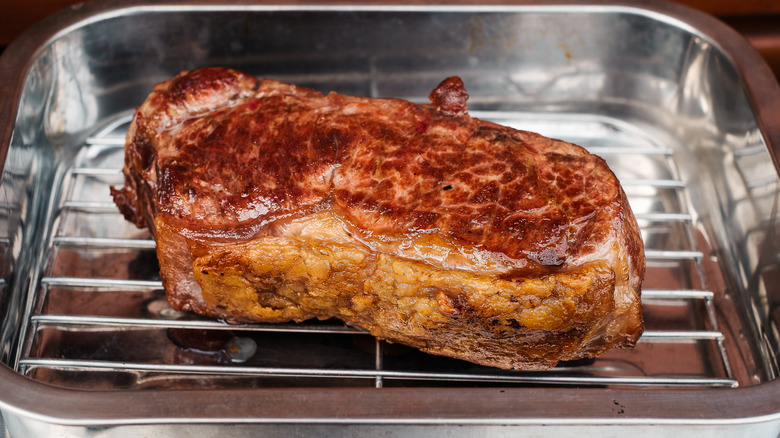Chef-Approved Secrets For The Juiciest Steaks You'll Wish You Knew Sooner
Cooking steak can be daunting. When done right, a perfect steak is heavenly — tender, flavorful, and, of course, juicy. A dry steak, on the other hand, can ruin both your meal and your whole day. To make sure this never happens again, we spoke with three steak savants who live, breathe, and eat steaks at their restaurants across Los Angeles.
Marcell Hatten is the chef de cuisine at Gwen Butcher Shop & Restaurant, a Michelin-starred establishment in the middle of Hollywood specializing in cooking thick cuts of meat utilizing live-fire cooking techniques. Chef Nancy Silverton is the co-owner of several popular Italian restaurants across L.A., including Osteria Mozza and Chi Spacca. Josiah Citrin, our final expert chef, is a bit of a Los Angeles legend. He owns and operates several restaurants, including Openaire and Citrin and Mélisse. His longest-running and most famous establishment, Dear John's steakhouse, made our list of the best restaurants in Los Angeles. Chef Marcell and Chef Josiah share their tips for cooking the best, juiciest steak possible.
Choose the right cuts of beef
Chef Marcell Hatten, Chef Josiah Citrin, and Chef Nancy Silverton agree: Not all cuts of steak are created equal. Almost all of them, though, will still grant you a pretty good meal. "The juiciness, or really the tenderness, comes from the cut of steak that you're cooking," says Chef Nancy.
"Certain cuts are more flavorful," agrees Chef Josiah, "but most steaks can all be juicy. Filet is tender and less fat, ribeyes have a bit more chew and are fatty with bold flavor. Hanger steaks have a richer meat flavor," he says, "the most important is to know your tastes in steaks."
Chef Marcell has his own preferred taste when it comes to steaks. "The ribeye is the juiciest cut — the fat content keeps the steak tender with a beefy flavor," he says, "conversely, lower fat steaks like a filet can still be tender but not as juicy." Though different cuts will have different flavors and mouthfeels, the white marbling throughout is what gives the meat its rich, juicy flavor. When buying whichever cut of meat you choose, look for one with a bit of white marbling throughout the red meat for the most juicy steak possible.
Bring the steak to room temperature
The first tip for cooking a juicy steak is one you may have heard before, but it is always worth repeating. Take the steaks out of the fridge and let them adjust to room temperature before cooking them. You never want to put a cold — or, even worse, frozen — steak directly onto the heat source.
"By tempering the steak first, you are ensuring that you are getting an even cook," says Chef Nancy Silverton, "The outer edges of the steak will look well done, but the center will end up being rarer than you likely desire." Chef Marcell Hatten agrees, advising to "temper steak for at least 30 minutes before cooking." Tempering your steak can be done as you begin to prep, which will cuts down on your cooking time. Just pull your cut out of the fridge at the same time you start prepping other ingredients and preheating whichever instrument you decide to cook with.
Generously season the meat
They say less is more when it comes to flavoring your steak, but you still want to use generous amounts of seasonings to give your meat a nice flavor and char. "It's impossible to season the inside of a steak so seasoning the outside is really important," says Chef Marcell Hatten, "it's also going to give you that gorgeous crust you're looking for. Season the steaks with salt and pepper on both sides." While salt and pepper are necessary, you can also add other steak seasonings like a homemade dry coffee rub for added flavor.
Classic dry seasonings are a must, but a marinade is not always necessary to guarantee a nice, juicy steak. "Marinating does not necessarily make it juicier," says Chef Josiah Citrin, "it can tenderize and add different flavors to the steaks." For a simple steak marinade, combine soy sauce, brown sugar, garlic, and some oil.
Utilize oil correctly
Using oil while cooking your steaks is important, but a little will go a long way. "You don't need a lot of oil," says Chef Marcell Hatten, "I like to rub a little bit over the steaks, but some people prefer to brush it over the grill to prevent sticking."
"For searing a steak, it's best to use a neutral, high smoke point oil such as soybean, grape seed, or canola," instructs Chef Nancy Silverton, "it's not the end of the world if you're a home cook and you use olive oil, but you need to then pay closer attention to avoid the oil getting too hot." Overheating your oil can lead to a burnt steak, reducing its juiciness. Add around two teaspoons of a high smoke point oil to the steaks or directly to your pan before cooking. If the steak sticks to the pan due to lack of oil, the seared top layer may rip and cause the juices to escape before they are done cooking.
Use the right pan
If you're sticking to stovetop, there's no better pan you can use than a classic vintage cast iron. These pans retain heat well and allow the steaks to marinate in their own liquid while still developing a nice crust. Cooking the steak in its own juices is a surefire way to have a juicy steak.
Chef Marcell Hatten shares his own way of cooking steaks, "we cook all of our steaks over a live fire," he says, "the wood used imparts flavor to their finished product." If you don't happen to have an in-house fire pit, your backyard grill will work in a similar matter. Most master grillers will suggest using a 2-zone fire to barbecue is key to steak perfection. Typically, this means having a hot side and a cool side to the grill to cook your meat at different temperatures. This allows the outside to develop a crisp sear while keeping the inside of the steak nice and juicy.
Preheat on low heat
While the steaks are cooling to room temperature, get the pan or grill nice and hot. Without preheating, your steaks won't get the char that signifies a perfectly cooked steak. Chef Nancy Silverton agrees: " If the pan isn't hot enough, the steak [will] steam in the pan instead of sear, which gives you that nice brown crust on the outside without overcooking the center."
Everyone knows that a steak is only as good as its slightly burnt outside layer — no matter how juicy the meat is inside. "Make sure to preheat your pan or grill surface so you get a nice sear on your steak," confirms Chef Marcell Hatten, "always start with a sear on both sides on high heat and then move the steak to a cooler part of the grill or lower your heat." This allows the steak to continue cooking on the inside without getting too burnt on the outside.
Turn the steaks frequently
Turning the steaks as you cook them is a key component for all three of our professional chefs. Chef Marcell Hatten's describes his approach, instructing to "turn steaks frequently, about one time every minute, in a hot pan to cook evenly and build a seared crust on the exterior." He recommends cooking steaks until they reach 125 degrees — but not much higher.
"Turning the steak cooks both sides evenly since the heat is being distributed to both sides," agrees Chef Nancy Silverton, "but the nice thing that happens is that the first side you sear then gets to rest when you flip it to the other side — as opposed to overcooking it." Keeping the steaks sedentary for too long gives them the opportunity to overheat on one side, leading to an unevenly cooked steak that will turn out less juicy than it should.
Flipping the steak is key to keep juiciness
While flipping the meat will allow the steaks to cook evenly and maintain all of their juices, you want them to first garner a nice deep sear. "For that caramelized crust, once you put the steak in the pan or on the grill, don't mess with it," says Chef Marcell Hatten, "it needs to stay in contact with the grill or pan for at least a minute until it's deep golden brown."
Start the steaks on a high heat to allow them to sear before flipping them over. "You can get an equally juicy steak on low heat or high heat," Chef Josiah Citrin tells us, "I prefer cooking on high heat, turning a lot and resting the meat often to control the temperature of the meat, never letting it get too hot." Chef Marcell agrees, advising us to start searing the steaks on a high heat before lowering the temperature to a medium-high heat. Though the chefs' methods vary, it all comes down to your tastes and preferences while cooking steak.
Top the steaks with butter
All three of our experts — Chef Josiah Citrin, Chef Nancy Silverton, and Chef Marcell Hatten — agree that marinating a steak before cooking does not necessarily make it more juicy. Adding some cold or room temperature butter on top towards the end, though, really does kick up the flavor. "Topping it with butter will add flavor and tenderize the steak," says Chef Nancy, "but it won't make it juicier."
Tenderizing is the process by which the meat's connective tissue is broken down, making it less chewy and easier to eat. Mix a dollop of butter with garlic, honey, or herbs like rosemary or thyme. Throw the heap of butter on top of the steak a few seconds prior to removing it from the heat. Real butter makes the richest flavor, but butter substitutes like margarine will also do the trick. Allow the butter to melt as you continue to the final, possibly most important step.
Let the steaks rest
The last tip, and potentially the most important of all, is to let the cooked steaks rest on a wire rack for a few minutes before serving them. Its a test of willpower to let the hot, delicious steaks sit untouched, but they will be well worth the wait.
"Rest cooked steak on rack over sheet tray for about half the amount of cooking time before slicing to ensure steak retains all juices," says Chef Marcell Hatten, "resting is the best technique for keeping a steak juicy. Letting a steak rest after removing it from your heat source will allow the juices to redistribute so they won't run out as soon as you slice it."
You may want to practice some carryover cooking which is where you remove the steak from the heat just shy of it's intended temperature and let the heat in the meat continue to cook while the resting begins. This will avoid overcooking the steak therefore drying it out Once your steak is rested, you're ready to serve a perfectly tender meal.
